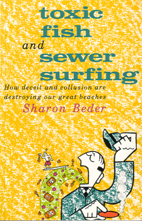
by Sharon Beder
first published by Allen & Unwin, Sydney, 1989
Introduction
Sewers seaward
Toothless watchdog
Toxic fish
Sewer-side surfing
Public relations battle
Events of 1989
Beyond Sydney
Conclusion
Bibliography
The most influential person to oppose the ocean outfall proposal was the ‘gallant knight’, Sir James Martin, Chief Justice of the colony. In 1880 he helped to found the Sanitary Reform League, originally named the League for the Prevention of Pollution of Air and Water, which was almost certainly Australia’s earliest environment movement. Martin and the League proposed that sewage should be considered as a valuable fertiliser to be utilised rather than a waste product to be dumped. They advocated sewage farms, where the sewage could be treated on land and crops grown from the enriched soil. Many Sydneysiders had been impressed by the ‘immense’ vegetables produced by Chinese market gardeners who made use of sewage as a fertiliser without any ill effects. Furthermore, sewage farms were being used overseas with varying degrees of success.
Although most engineers preferred ocean disposal, because of the minimal costs and maintenance problems, in the case of Sydney's south draining sewage it was considered too expensive first-off because of the long distance to the open ocean. A sewage farm was therefore established on the way to the ocean on the edge of Botany Bay next to the Cooks River. It would be an experiment and little would be wasted if it didn’t work because the sewers could later be extended to the sea and the land sold. Moreover, sewage farms had broad popular appeal and made good political sense. One member of the Sewage and Hea1th Board said, ‘I feel sure the inhabitants of this city would be more satisfied to go to the expense of a second great sewer when they know that sewage farms will not answer. l do not think they will be satisfied until the experiment has been made.’
Although the sewage farm was little more than a half-hearted experiment, a staging post on the way to the ocean, it turned out to be remarkably successful for the first ten years of its operation. Sewage was first turned onto the farm in 1887. In the following years cabbages, turnips, lucerne and sorghum were grown and found a ready market. Paddocks were laid out in grass for agistment of cattle and the raising of pigs on the farm turned out to be particularly profitable.
Sydney's sewage farm, established in 1887 on the edge of Botany Bay, operated for several years before it became over-loaded and ‘sewage sick’. Vegetables were grown on it, cattle agisted and the pigs bred there were particularly profitable. It was decided in 1906 to extend the sewer main to the ocean at Long Bay (Malabar). [Source: Water Board Archives]
More and more sewage was directed to the farm and when the western suburbs of the city were sewered, the area of the farm was expanded to take that as well. However, the expansion of the farm could not keep up with the added load of sewage and it soon became overloaded, waterlogged and generally ‘sewage sick’. As the population of the surrounding neighbourhoods grew, so did the complaints. However, the newly-formed Water Board was slow to admit that the farm was the source of pollution in the area, and in a public relations exercise that was to set the tone for the future, the Board put out that the smells were coming from Chinese gardens and from wool-scouring and boiling-down establishments at Alexandria and Botany. In response to the claims of local fishermen that fish were becoming scarce in the Cooks River and that people were reluctant to buy fish caught there, the Board’s medical officer said he had never noticed that there was a fishing industry at the Cooks River, and, anyway, sewage did not harm fish. There was no danger to health, he said.
In contrast the President of the Board of Hea1th confirmed that his Board considered the sewage farm to be a nuisance, and a later government report admitted the sewage farm gave off ‘exceedingly disagreeable and offensive’ odours. A 1908 Parliamentary Standing Committee Report said the sewage farm was unworkable because the raw sand did not contain enough organisms to break down the sewage properly and the low-lying land was periodically saturated with salt water because of tides in the area. So it was decided in 1908 to continue the sewer main, as originally advocated, from the sewage farm to the headland on the north side of Long Bay. No further effort was made to expand upon the idea of sewage farms. More sewage would be discharged untreated into the ocean, in spite of the mounting evidence of pollution at Bondi Beach.